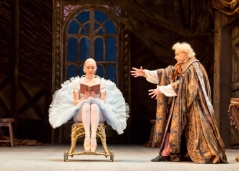Coppélia - Ballet - Bristol Theatre Review

Posted on: 2017-07-03
Our rating:
"The set for this act is clever and beautiful. Richly textured and decorated, the unnatural angles perfectly create a feeling of magical reality; we are in our world, but not quite."
I love watching ballet, but will be the first to put up my hand and say that my love is based entirely on adoration and that I have absolutely zero technical knowledge; I unashamedly love the tutus, the dancing en pointe, and choreography that makes the dancers appear super-human. On these counts, Birmingham Royal Ballet’s production of Coppelia ticks all my adoration boxes.
Set in a sleepy town in Eastern Europe, Coppelia tells the story of inventor Dr Coppelius, and of continually-feuding lovers, Swanhilda and Franz. Act One introduces us to the eccentric Dr Coppelius as he places his mechanical doll, Coppelia, on his balcony. Swanhilda spots Coppelia and tries her best to get her to look up from the book she is reading. Swanhilda fails and is grumpy. Out of Swanhilda’s sight, Dr Coppelius winds up Coppelia, and the doll waves and blows kisses to Franz below. Neither Franz nor Swanhilda realises that she is a doll, and Swanhilda is most put out that Franz appears to prefer another girl.

The set for this act is clever and beautiful. Richly textured and decorated, the unnatural angles perfectly create a feeling of magical reality; we are in our world, but not quite.
As the story continues, Swanhilda tests Franz’s fidelity with an ear or corn, and a fete is announced to celebrate the installation of a new church bell.
The choreography in this act is very much dance-acting; even if you’re unaware of the plot in advance, it would be very easy to follow. At the end of the act, we see Swanhilda entering Dr Coppelius’ workshop, and Franz about to climb a ladder to look for Coppelia.
After an interval, Act Two opens to another sumptuous set. We are now inside Dr Coppelius’ workshop. Swanhilda and her friends create all sorts of havoc, and are chased away by the returning Dr Coppelius. The dancing is, of course, the star, but I loved the layers of detail in the set design, especially the bubbling chemistry set. We meet Coppelia who has been brought to life with magic, and we begin to appreciate the true depth of Swanhilda’s feelings for Franz.
After another interval, Act Three opens with a much simpler but still very beautiful set. Where the set was more simple, the costumes were more sumptuous, with glitter and lace at every turn. Act Three brings us to the day of the fete, with many short dances to celebrate. The highpoint of the evening for me was in set three, with The Dance of the Hours. Named only as ‘artists of Birmingham Royal Ballet’ the dancers in this section were wonderful. When I think of ballet, I think of dances like this. It was frothy, bubbly, playful and elegant. Within this act, we also have the dance of Prayer, danced beautifully by Delia Mathews, who seemed to float across the stage. My friend and I were mesmerised by her speed and delicacy. Coppelia ends, of course, with happy endings all round.
Coppelia’s enduring charm is down to its sense of fun, its joyous score, and its accessibility. Although commonly thought of as a ballet for children, this production’s audience had more than its fair share of enraptured adults too. After all, what’s not to love about tutus, pointe shoes and happy endings?
For further info on the wonderful Birmingham Royal Balet and subsequent shows please visit www.brb.org.uk
Article by:

Sarah is a writer and blogger, as well as running workshops and teaching. Her passions are food and travel, and you can follow her on Instagram at YesStarling and find her website at www.yesstarling.com .

